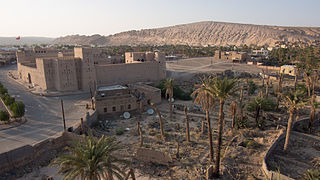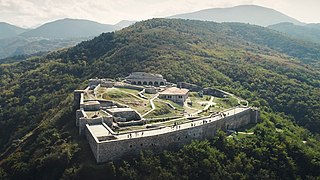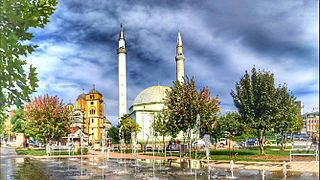
A tumulus is a mound of earth and stones raised over a grave or graves. Tumuli are also known as barrows, burial mounds or kurgans, and may be found throughout much of the world. A cairn, which is a mound of stones built for various purposes, may also originally have been a tumulus.

Singidunum was an ancient city which later evolved into modern Belgrade, the capital of Serbia. The name is of Celtic origin, going back to the time when Celtic tribe Scordisci settled the area in the 3rd century BC, following the Gallic invasion of the Balkans. Later on, the Roman Republic conquered the area in 75 BC and incorporated it into the province of Moesia. It was an important fort of the Danubian Limes and Roman Legio IV Flavia Felix was garrisoned there since 86 AD. Singidunum was the birthplace of the Roman Emperor Jovian. It was sacked by Huns in 441, and by Avars and Slavs in 584. At the beginning of the 7th century, the Singidunum fort was finally destroyed.

Elaiussa Sebaste or Elaeousa Sebaste was an ancient Roman town located 55 km (34 mi) from Mersin in the direction of Silifke in Cilicia on the southern coast of Anatolia.

Ibri is a city and Wilāyat (Province) in the Governorate Ad Dhahirah, in northwest Oman.

Ulpiana was an ancient Roman city located in what is today Kosovo. It was also named Justiniana Secunda. Ulpiana is situated in the municipality of Lipjan. The Minicipium Ulpiana - Iustiniana Secunda was proclaimed archaeological park under permanent protection of Kosovo by the Kosova Council for Cultural Heritage in 2016. The protection zone of the Archaeological Park has 96.23 ha and includes also Justinopolis, constructed during the reign of Justinian. Ulpiana was among the largest settlements in the Balkans of the late antiquity.

The Archaeological Museum of Dion is a museum in Dion in the Pieria regional unit of Central Macedonia, Greece.

Prusias ad Hypium was a city in ancient Bithynia, and afterwards in the late Roman province of Honorias. In the 4th century it became a bishopric that was a suffragan of Claudiopolis in Honoriade. Before its conquest by King Prusias I of Bithynia, it was named Cierus or Kieros. Photius writes that it was called Kieros, after the river which flows by it.

Prizren Fortress is a hilltop fortification in Prizren in Kosovo. It overlooks the Prizren River which flows through Prizren, which developed around the fortress. The site of the fortress of Prizren has seen habitation and use since the Bronze Age. In late antiquity it was part of the defensive fortification system in western Dardania and was reconstructed in the era of eastern Roman Emperor Justinian. Byzantine rule in the region ended definitively in 1219–20 as the Serbian Nemanjić dynasty controlled the fort until 1371.

Municipium Dardanorum or Municipium Dardanicum was a Roman mining town whose life lasted from the 2nd to the 4th century AD, that was connected with the workings of. Its remains are situated in the northern part of Kosovo, located approximately 27 kilometres north of Mitrovica, about 65 km northeast of Ulpiana in the Municipality of Leposavic, localized in the village of Sočanica in the province of Moesia Superior, later the Roman province of Dardania.

Ferizaj or Uroševac is the sixth largest city in Kosovo by population and seat of Ferizaj Municipality and Ferizaj District.

Archaeology of Kosovo as a field of study and research was started in the second half of the 20th century. Kosovo's field of archaeology has developed in tandem with the historical study, studies of ancient authors' sources, classic philological studies, theological data research, topographic studies and ground survey, analysis of toponyms, deciphering of epigraphic and historiographic data. First data about antique monuments in Kosovo, were documented from the end of the 19th until the beginning of the Second World War, a time period when Kosovo was visited by researchers, guides, and archaeologists such as: Evans, Boue, Hahn, Kanitz, Tomaschek, Domaschevski, Arpad, Vulic, Jirecek, Patsch, Domenico Mustilli, etc.

Part of series of articles upon Archaeology of Kosovo
Part of series of articles upon Archaeology of Kosovo

The Roman heritage sites in Kosovo represent a multitude of monuments of material and spiritual culture, which reflect the Roman period in this region. Among them, a special place is occupied by those that represent the development of art, such as the plastic monuments that are more frequent, and at the same time occupy an important place, because with the presentation of figures in relief and with numerous inscriptions they speak to us enough for this period.

Part of a series of articles upon Archaeology of Kosovo

Part of a series of articles upon Archaeology of Kosovo
Nerodimë e Poshtme or Donje Nerodimlje is an archaeological site and village situated west of the city of Ferizaj, Kosovo. Several archaeological trenches were investigated at this location in 1988.

Idebessos or Idebessus, also known as Edebessus or Edebessos or, was an ancient city in Lycia. It was located at the foot of the Bey Mountains to the west of the Alakır river valley. Today its ruins are found a short distance to the west of the small village of Kozağacı in the Kumluca district of Antalya Province, Turkey. The site, 21 kilometres north-northwest of Kumluca, is overgrown with forest and hard to reach.
The strategic position of the region of Mitrovica in the middle of two great rivers Ibar and Sitnica and its mineral wealth in Albanik, made this location populated since prehistoric period. This region was populated by Illyrians, respectively members of the Dardan tribe. The first data for the archaeological sites in the region of Mitrovica, begin with the researches of Sir Artur John Evans, who was the first to pinpoint the Roman town of the Municipium Dardanourm. In the archaeological sites of the region of Mitrovica were found traces and objects from different periods such as; Neolithic, Roman, late antiquity and medieval period. Objects and figurines include: fortress vestiges, necropolis, Terpsichore figure, statues, sarcophagus, altar, jewelry, etc.

Archaeological Site Pionirski Park is one of the most important archaeological sites in Serbia. Protective and systematic researches of ancient Singidunum have been lasting for more than a hundred years. Unfortunately, at the beginning of the 21st century, knowledge of this city is still shallow compared to the knowledge of the history of other ancient cities that have been explored for so long. One of the reasons for this, is the fact that above the ancient Singidunum grew modern Belgrade whose construction destroyed the earlier cultural layers.














